In The Studio
Stiv Bators in a quiet moment, in the vocal booth at a studio in Sun Valley ("where's the sun?" they always asked; every day) recording his solo album, "Disconnected."
Despite the chaos and mayhem Stiv, The Dead Boys, or any of this bands displayed onstage, they did stop the madness momentarily to commit sounds to tape, for your ultimate vinyl listening pleasure.
Not that any recording session with Stiv & crew was calm or boring business as usual... there were always hijinx.
Just one look comparing my studio photo for a record cover, versus David Arnoff's unique candid shot, you can tell there was never a dull moment: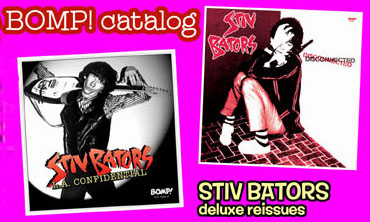
The image on the left is one of my shots. Greg Shaw asked me to bring all my studio stuff (lights, backdrops) into the recording studio and take some suitable album cover shots. And I did. We basically moved into the studio anyway. We got a lot of great pictures during the recording sessions, and lots of them ended up on and inside the "Disconnected" record (and now CD booklet). However, when the going got rough, I had a tendency to leave, volunteering to fetch the pizza or Taco Bell (oh, and Taco Bell completely fuelled those recordings!).
And by "rough," I mean firearms and other assorted barely legal goings-on.
Luckily for you, David Arnoff was not spooked by guns (even realistic toy guns; I just didn't take any chances). One night when I wasn't there, David was. Voila! On the right, his fantastic picture of Stiv, pistol (real or toy - you'll never know) that became the cover of "Disconnected."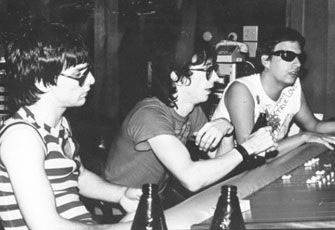
Here's a typical and sedate studio picture, capturing Stiv seated in between his boy-wonder drummer, David "Quinton" Steinberg and a then-unknown recording engineer, Thom Wilson. Quinton was a youngster (only 18 at the time) Stiv lured away from the safety of the Toronto mod scene (David was in The Mods) to replace Johnny Blitz in the Dead Boys, which led to a stint with Stiv's solo career. Thom Wilson was an adept engineer who agreed to work for an indie budget, and Stiv taught Thom a lot about rock n roll reality. Years later, Thom's credits include The Offspring and Madonna, to name a couple artists you just may have heard of.
True to low-budget indie recording, we were way out in the Valley - as far away from Hollywood as one could possibly be, Sun Valley. The studio was an old industrial building and as such, was big enough to house a regulation-size basketball court. We did not let that opportunity slip.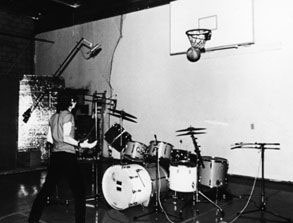
Here, Frank Secich and George Cabaniss don't hold anything back even though the only audience was the camera.
I'd have to say that being in the studio with Stiv while he made his first and only solo album was one of the most fun and gratifying experiences I've had. It was such a family-bonding kind of adventure, the kind where the people closest to you exasperate the hell outta you (mostly Stiv), yet you love them just the same and defend them even when other people may have the exact same beef you had. All those Disconnected band guys and I are still friends and even though it had been some 20 years between our last and most recent meetings, when we did see each other again, it was like 20 days had passed instead of 20 years. Brothers...
I've been in posh studios with bands on big budget projects. Sure, there's nothing like Sony Music Studios with their bowls of candy everywhere and incredible wine cellar. And what location could possibly match the calm, natural beauty of the Bahamas and Chris Blackwell's Compass Point Studios.
Trust me, you want to be here in the winter!
These days, just about all my favorite records seem to be recorded in one place: Detroit's Ghetto Recorders, with Jim Diamond at the controls.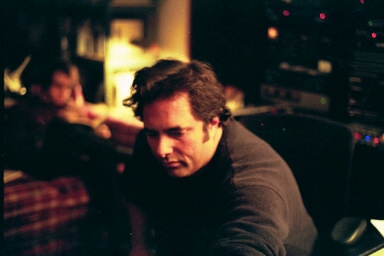
If I were to name-check my list of fave records that came from this studio, this page would scroll on and on. Its worth visiting the Ghetto Recorders website to see the list of bands that have recorded there and hear the MP3's of representative songs. Just a sampling of great bands that made great records in the Ghetto:
The Witches, Compulsive Gamblers, The Dirtbombs, New Bomb Turks, This Moment in Black History, and this little band from Detroit, The White Stripes.
My conclusion here is that while I've got nothing against posh (really, why turn down comfort?), the best records have been made in the most trying of circumstances and most challenging of settings. Much as I love distressed industrial and post-industrial locations, they're bitterly freezing cold in the winter and stifling hot in the summer. You have to keep one eye out the window to make sure your car isn't vandalized, and you have to go in teams to fetch the pizza because you're probably in a deserted as well as dubious neighborhood. But it all feeds the creative monster exactly the food it needs: excitement, edge and the great unknown.
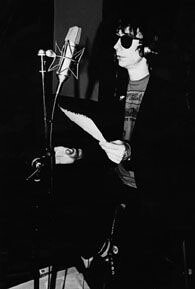

Comments